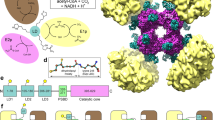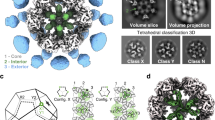Abstract
Enolase or 2-phospho-D-glycerate hydrolase catalyses the dehydration of 2-phosphoglycerate to phosphoenolpyruvate, which in turn is converted by pyruvate kinase to pyruvate. We describe here the crystallographic determination of the structure of yeast enolase at high resolution (2.25 Å) and an analysis of the structural homology between enolase, pyruvate kinase and triose phosphate isomerase. Each of the two subunits of enolase forms two distinctive domains. The larger domain (residues 143–420) is a regular 8-fold β/α-barrel, as first found in triose phosphate isomerase, and later in pyruvate kinase and 11 other functionally different enzymes. An analysis of the molecular geometries of enolase and pyruvate kinase based on the roughly 8-fold symmetry of the barrel showed a structural homology better than expected for proteins related by convergent evolution. We argue that enolase and pyruvate kinase have evolved from a common ancestral multifunctional enzyme which could process phosphoenolpyruvate in both directions along the glycolytic pathway. There is structural and sequence evidence that muconate lactonizing enzyme later evolved from enolase.
This is a preview of subscription content, access via your institution
Access options
Subscribe to this journal
Receive 51 print issues and online access
$199.00 per year
only $3.90 per issue
Buy this article
- Purchase on Springer Link
- Instant access to full article PDF
Prices may be subject to local taxes which are calculated during checkout
Similar content being viewed by others
References
Lebioda, L. & Brewer, J. M. J. molec. Biol. 180, 213–215 (1984).
Wang, B.-C. Meth. Enzym. 115, 90–111 (1985).
Chin, C. C. Q., Brewer, J. M. & Wold, F. J. biol. Chem. 256, 1377–1384 (1981).
Holland, M. J., Holland, J. P., Thill, G. P. & Jackson, K. A. J. biol. Chem. 256, 1385–1395 (1981).
Brewer, J. M. Crit. Rev. Biochem. 11, 209–254 (1981).
Elliott, J. I. & Brewer, J. M. Arch. Biochem. Biophys. 192, 203–213 (1979).
Banner, D. W. et al. Nature 255, 609–614 (1975).
Stuart, D. I., Levine, M., Muirhead, H. & Stammers, D. K. J. molec. Biol. 134, 109–142 (1979).
Mavridis, J. M., Hatada, M. H., Tulinsky, A. & Lebioda, L. J. molec. Biol. 162, 419–444 (1982).
Sygusch, J., Beaudry, D. & Allaire, M. Proc. natn. Acad. Sci. U.S.A. 84, 7846–7850 (1987).
Matsuura, Y., Kusunoki, M., Harada, W. & Kakudo, M. J. Biochem. 95, 697–702 (1984).
Carrell, H. L., Rubin, B. H., Hurley, T. J. & Glusker, J. P. J. biol. Chem. 259, 3230–3236 (1984).
Lindqvist, Y. & Brändén, C.-I. Proc. natn. Acad. Sci. U.S.A. 82, 6855–6859 (1985).
Schneider, G., Lindqvist, Y., Brändén, C.-I. & Lorimer, G. EMBO J 5, 3409–3415 (1986).
Goldman, A., Ollis, D. L. & Steitz, T. A. J. molec. Biol. 194, 143–153 (1987).
Hyde, C. C., Padlan, E. A., Ahmed, S. A., Miles, E. W. & Davies, D. R. Fedn Proc. 46, 2215 (1987).
Lim, L. W. et al. J. biol. Chem. 261, 15140–15146 (1986).
Xia, Z. X. et al. Proc. natn. Acad. Sci. U.S.A. 84, 2629–2633 (1987).
Priestle, J. P. et al. Proc. natn. Acad. Sci. U.S.A. 84, 5690–5694 (1987).
Rossmann, M. G. Phil. Trans. R. Soc. B293, 191–203 (1981).
Lebioda, L., Hatada, M. H., Tulinsky, A. & Mavridis, I. M. J. molec. Biol. 162, 445–458 (1982).
Muirhead, H. Trends biochem. Sci. 8, 326–330 (1983).
Fothergill-Gilmore, L. A. in Multidomain Proteins-Structure and Evolution (ed. Hardie, D. G. & Coggins, J. R.) 85–174 (Elseiver, Amsterdam, 1986).
Schulz, G. E. Angew. Chem. 20, 143–151 (1981).
Yeh, W. K. & Ornston, L. N. Proc. natn. Acad. Sci. U.S.A. 77, 5365–5369 (1980).
Rose, I. A. Meth. Enzym. 87, 84–97 (1982).
Horowitz, N. H. Proc. natn. Acad. Sci. U.S.A. 31, 153–156 (1945).
Horowitz, N. H. in Evolving Genes and Proteins (ed. Bryson, V. & Vogel, H. J.) 15–26 (Academic, New York, 1965).
Rossmann, M. G. & Argos, P. J. biol. Chem. 250, 7525–7532 (1975).
Author information
Authors and Affiliations
Rights and permissions
About this article
Cite this article
Lebioda, L., Stec, B. Crystal structure of enolase indicates that enolase and pyruvate kinase evolved from a common ancestor. Nature 333, 683–686 (1988). https://doi.org/10.1038/333683a0
Received:
Accepted:
Issue Date:
DOI: https://doi.org/10.1038/333683a0
This article is cited by
-
Analysis of Proteins, Protein Complexes, and Organellar Proteomes Using Sheathless Capillary Zone Electrophoresis - Native Mass Spectrometry
Journal of the American Society for Mass Spectrometry (2017)
-
Neuron specific enolase: a promising therapeutic target in acute spinal cord injury
Metabolic Brain Disease (2016)
-
Increased expression of enolase α in human breast cancer confers tamoxifen resistance in human breast cancer cells
Breast Cancer Research and Treatment (2010)
-
Characterization of enolase fromClostridium difficile
Current Microbiology (1993)
-
Evolution of parallel β/α-barrel enzyme family lightened by structural data on starch-processing enzymes
Journal of Protein Chemistry (1993)
Comments
By submitting a comment you agree to abide by our Terms and Community Guidelines. If you find something abusive or that does not comply with our terms or guidelines please flag it as inappropriate.



